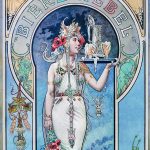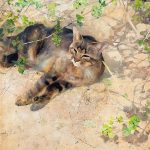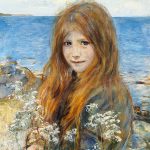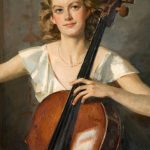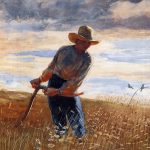Abbott Handerson Thayer, born on August 12, 1849, in Boston, Massachusetts, was an American artist who left an indelible mark on the worlds of painting and natural history. Thayer’s work, characterized by its ethereal beauty and scientific accuracy, straddles the line between art and environmental observation, making him a unique figure in the annals of American art history.
Thayer grew up in a family that encouraged his artistic inclinations. His father was a country doctor and amateur painter, while his mother nurtured his early interest in nature. This blend of influences would shape Thayer’s career, guiding him towards subjects that combined his love for the natural world with his artistic talents. He received his formal art education at the École des Beaux-Arts in Paris, where he studied under Jean-Léon Gérôme, a prominent French painter known for his precision and academic style. This training instilled in Thayer a meticulous approach to his work, both in terms of technique and subject matter.
Upon returning to the United States, Thayer settled in rural New Hampshire, where he found inspiration in the local landscape and wildlife. His early works were primarily landscapes and portraits, but he is most renowned for his paintings of angels and figures that embody a serene, transcendent beauty. These works, often featuring women and children against a backdrop of nature, are celebrated for their spiritual quality and the way they capture the essence of his subjects with grace and sensitivity.
One of Thayer’s most significant contributions to art and science is his work on animal camouflage. He is often credited with discovering the principle of “countershading,” a form of camouflage found in the animal kingdom. Thayer observed that animals are often darker on their upper surfaces and lighter underneath, a natural gradient that helps obscure their shape from predators. He passionately argued that artists, with their acute observational skills and understanding of light and color, could offer valuable insights into the study of camouflage. His book, “Concealing-Coloration in the Animal Kingdom,” co-authored with his son Gerald H. Thayer, presented a comprehensive argument for the role of visual deception in animal and military camouflage. Although some of Thayer’s ideas were met with skepticism from scientists, his research has been influential in the development of camouflage techniques in military strategy.
Thayer’s commitment to the intersection of art and science was matched by his dedication to teaching. He mentored many young artists, sharing his deep knowledge of painting techniques and encouraging them to draw inspiration from the natural world. His influence extended beyond his immediate circle, impacting the broader art community and contributing to a growing appreciation for the links between artistic representation and environmental observation.
Despite his successes, Thayer faced personal challenges, including bouts of depression and financial difficulties. However, he continued to produce work that resonated with audiences, earning him accolades and exhibitions at prestigious venues. His paintings are now housed in major museums across the United States, where they continue to captivate viewers with their beauty and depth.
Thayer’s legacy is multifaceted. As an artist, he is remembered for his luminous paintings that convey a profound sense of peace and sanctity. As a naturalist, his observations and theories about camouflage have earned him recognition as a pioneer in the field of visual perception. Through his teaching, he influenced generations of artists, encouraging them to seek inspiration in the beauty and complexity of the natural world.
Abbott Handerson Thayer passed away on May 29, 1921, in Dublin, New Hampshire. His life’s work stands as a testament to the power of art to illuminate the mysteries of nature and the human spirit. In both his artistic creations and his scientific explorations, Thayer embodied the ideal of the Renaissance man, bridging the gap between two worlds with his insatiable curiosity and boundless creativity. His contributions continue to inspire artists, scientists, and conservationists, making him a lasting figure in the cultural and scientific heritage of the United States.

